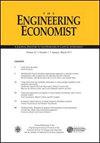The socioeconomic feasibility of greening rail stations: a case study in lisbon
IF 1.2
4区 经济学
Q4 BUSINESS
引用次数: 17
Abstract
Abstract Green roofs and living walls are considered effective solutions for improving the environmental integrity of urbanized areas and the overall performance of buildings. Proposals are emerging not just for buildings but also for existing transport infrastructures that have needs/problems that can be met or addressed by such solutions. However, the economic feasibility of such sustainable solutions has not yet been clarified. This study presents a methodological approach to performing cost–benefit analyses of greening urban transport infrastructures at the separate financial, economic, and socioenvironmental levels. Infrastructure, user, and environmental dimensions are also assessed. Whole life cycle costs and socioenvironmental benefits are considered together. The methodology is applied to one of the main stations in Lisbon, Portugal: Entrecampos Railway Station. Five different case study alternatives for the station’s retrofit with green infrastructures are compared to its current situation. The cost–benefit analysis demonstrated that all five greening alternatives are economically feasible. For a 50-year life cycle and a 3.36% discount rate, the net present value ranged between EUR 734,700 and EUR 7,733,279. A sensitivity analysis was also performed, revealing a high degree of influence of discount and inflation rates, recreation, aesthetics improvement, well-being, and the station noise reduction on the net present value, ranging from 1.5 to 9%.绿化火车站的社会经济可行性:以里斯本为例
绿色屋顶和生活墙被认为是改善城市化地区环境完整性和建筑整体性能的有效解决方案。目前出现的建议不仅适用于建筑物,也适用于现有的交通基础设施,这些基础设施的需求/问题可以通过此类解决方案得到满足或解决。然而,这种可持续解决办法的经济可行性尚未得到澄清。本研究提出了一种方法学方法,从财政、经济和社会环境三个层面对城市交通基础设施绿化进行成本效益分析。基础设施、用户和环境方面也进行了评估。整个生命周期的成本和社会环境效益是一起考虑的。该方法应用于葡萄牙里斯本的一个主要车站:Entrecampos火车站。五个不同的案例研究的车站改造与绿色基础设施的现状进行了比较。成本效益分析表明,所有五种绿色替代方案在经济上都是可行的。以50年的生命周期和3.36%的贴现率计算,净现值在734,700欧元至7,733,279欧元之间。还进行了敏感性分析,揭示了折扣率和通货膨胀率、娱乐、美学改善、福祉和车站噪声降低对净现值的高度影响,范围从1.5%到9%。
本文章由计算机程序翻译,如有差异,请以英文原文为准。
求助全文
约1分钟内获得全文
求助全文
来源期刊

Engineering Economist
ENGINEERING, INDUSTRIAL-OPERATIONS RESEARCH & MANAGEMENT SCIENCE
CiteScore
2.00
自引率
0.00%
发文量
14
审稿时长
>12 weeks
期刊介绍:
The Engineering Economist is a refereed journal published jointly by the Engineering Economy Division of the American Society of Engineering Education (ASEE) and the Institute of Industrial and Systems Engineers (IISE). The journal publishes articles, case studies, surveys, and book and software reviews that represent original research, current practice, and teaching involving problems of capital investment.
The journal seeks submissions in a number of areas, including, but not limited to: capital investment analysis, financial risk management, cost estimation and accounting, cost of capital, design economics, economic decision analysis, engineering economy education, research and development, and the analysis of public policy when it is relevant to the economic investment decisions made by engineers and technology managers.
 求助内容:
求助内容: 应助结果提醒方式:
应助结果提醒方式:


